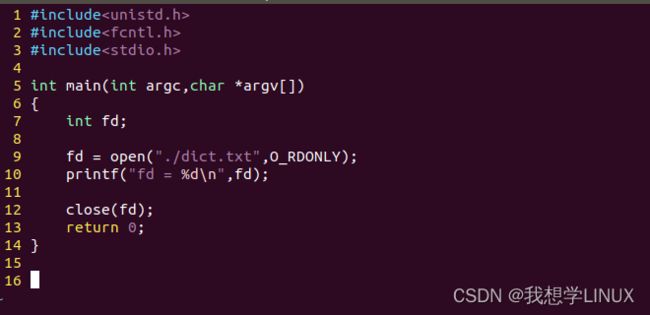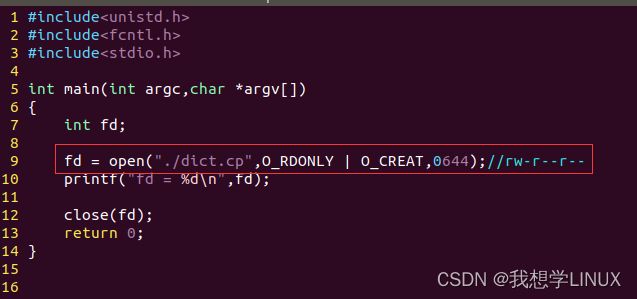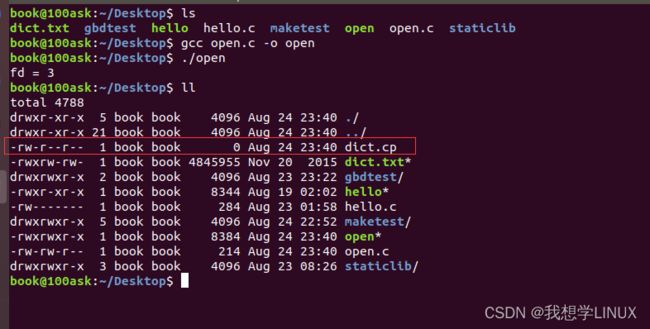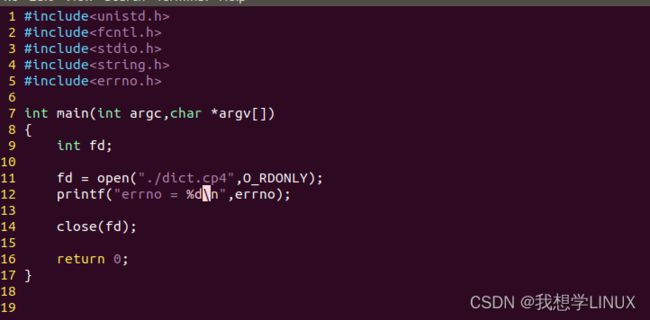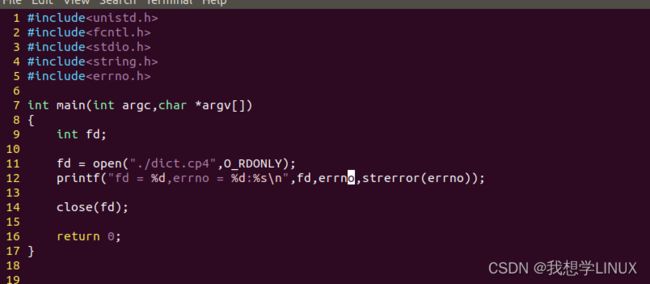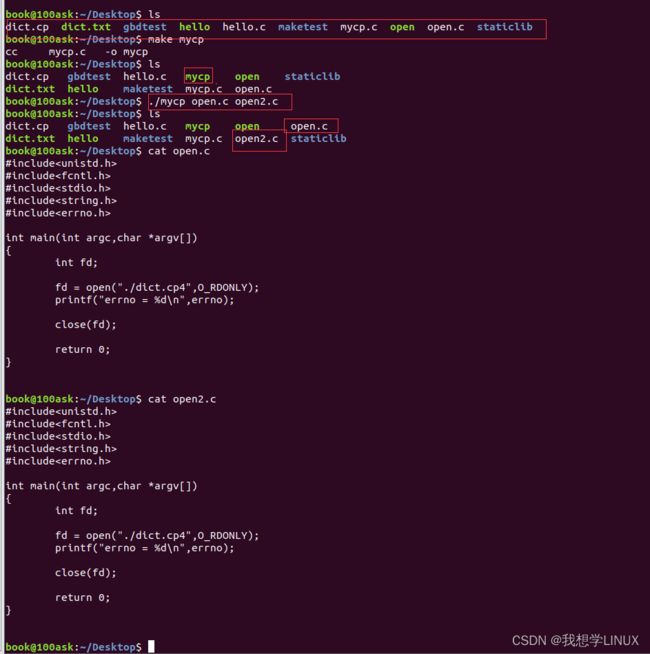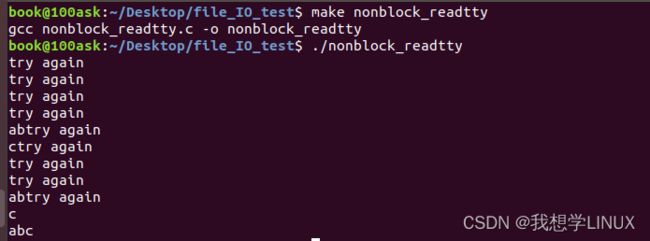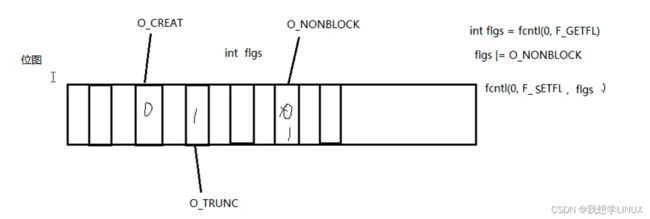Linux下的系统编程——系统调用(五)
前言:
由操作系统实现并提供给外部应用程序的编程接口。(Application Programming Interface,API)。系统调用就是应用程序同系统之间数据交互的桥梁。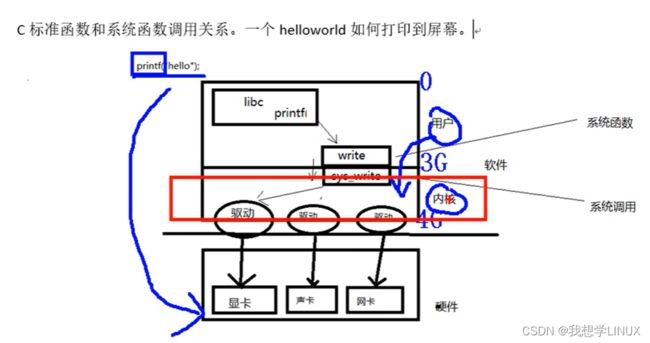
一、open/close函数
1.open函数:
(1)int open(char *pathname, int flags) #include
参数:
pathname: 欲打开的文件路径名
flags:文件打开方式: #include
O_RDONLY|O_WRONLY|O_RDWR O_CREAT|O_APPEND|O_TRUNC|O_EXCL|O_NONBLOCK ....
返回值:
成功: 打开文件所得到对应的 文件描述符(整数)
失败: -1, 设置errno
(2)int open(char *pathname, int flags, mode_t mode) 123 775
参数:
pathname: 欲打开的文件路径名
flags:文件打开方式:
O_RDONLY|O_WRONLY|O_RDWR O_CREAT|O_APPEND|O_TRUNC|O_EXCL|O_NONBLOCK ....
mode: 参数3使用的前提, 参2指定了 O_CREAT。
取值8进制数,用来描述文件的 访问权限。 rwx 0664
创建文件最终权限 = mode & ~umask
返回值:
成功: 打开文件所得到对应的 文件描述符(整数)
失败: -1, 设置errno
2.close函数:
int close(int fd);
3.错误处理函数:
与 errno 相关。
printf("xxx error: %d\n", errno);
char *strerror(int errnum);
printf("xxx error: %s\n", strerror(errno));
void perror(const char *s);
perror("open error");
二、read/write函数:
1.read函数:
ssize_t read(int fd, void *buf, size_t count);
参数:
fd: 文件描述符
buf: 存数据的缓冲区
count:缓冲区大小
返回值:
0: 读到文件末尾。
成功; > 0 读到的字节数。
失败: -1, 设置 errno
-1: 并且 errno = EAGIN 或 EWOULDBLOCK, 说明不是read失败,而是read在以非阻塞方式读一个设备文件(网络文件),并且文件无数据。
2.write函数:
ssize_t write(int fd, const void *buf, size_t count);
参数:
fd: 文件描述符
buf: 待写出数据的缓冲区
count:数据大小
返回值:
成功; 写入的字节数。
失败: -1, 设置 errno
示例:
用read和write函数实现cp操作(将open.c文件中的代码复制到open2.c中)
1 #include
2 #include
3 #include
4 #include
5 #include
6 #include
7
8 int main(int argc,char *argv[])
9 {
10 char buf[1024];
11
12 int n = 0;
13
14 int fd1 = open(argv[1],O_RDONLY); //read
15 if(fd1 == -1){
16 perror("open argv1 error");
17 exit(1);
18 }
19
20 int fd2 = open(argv[2],O_RDWR|O_CREAT|O_TRUNC,0664);
21 if(fd2 == -1){
22 perror("open argv2 error");
23 exit(1);
24 }
25 while((n = read(fd1,buf,1024))!=0){
26 if(n < 0)
27 {
28 perror("read error");
29 break;
30 }
31 write(fd2,buf,n);
32 }
33
34 close(fd1);
35 close(fd2);
36 }
~ 系统调用和库函数比较
预读入缓输出
三、阻塞、非阻塞
阻塞、非阻塞: 是设备文件、网络文件的属性。
产生阻塞的场景: 读设备文件、读网络文件。(读常规文件无阻塞概念。)
/dev/tty --> 终端文件。
1.阻塞
1 #include
2 #include
3 #include
4
5
6 int main(void)
7 {
8 char buf[10];
9 int n;
10
11 n = read(STDIN_FILENO, buf, 10);
12 // #define STDIN_FILENO 0 STDOUT_FILENO 1 STDERR_FILENO 2
13 if(n < 0){
14 perror("read STDIN_FILENO");
15 exit(1);
16 }
17 write(STDOUT_FILENO, buf, n);
18
19 return 0;
20 } 当我们输入一串字符时,读操作结束,阻塞解除
那么阻塞是谁的特性?是read/write的吗?
答案当然不是了,应该是文件的属性,也就是设备文件或者网络文件
2.改变阻塞特性
open("/dev/tty", O_ RDWR|O_NONBLOCK) --- 设置 /dev/tty 非阻塞状态。(默认为阻塞状态)
3.非阻塞
1 #include
2 #include
3 #include
4 #include
5 #include
6 #include
7
8 int main(void)
9 {
10 char buf[10];
11 int fd, n;
12
13 fd = open("/dev/tty", O_RDONLY|O_NONBLOCK);
14 if (fd < 0) {
15 perror("open /dev/tty");
16 exit(1);
17 }
18
19 tryagain:
20
21 n = read(fd, buf, 10);
22 if (n < 0) {
23 if (errno != EAGAIN) { // if(errno != EWOULDBLOCK)
24 perror("read /dev/tty");
25 exit(1);
26 } else {
27 write(STDOUT_FILENO, "try again\n", strlen("try again\n"));
28 sleep(2);
29 goto tryagain;
30 }
31 }
32
33 write(STDOUT_FILENO, buf, n);
34 close(fd);
35
36 return 0;
37 }
4.设置非阻塞后的循环停止时间
1 #include
2 #include
3 #include
4 #include
5 #include
6 #include
7
8 #define MSG_TRY "try again\n"
9 #define MSG_TIMEOUT "time out\n"
10
11 int main(void)
12 {
13 char buf[10];
14 int fd, n, i;
15
16 fd = open("/dev/tty", O_RDONLY|O_NONBLOCK);
17 if(fd < 0){
18 perror("open /dev/tty");
19 exit(1);
20 }
21 printf("open /dev/tty ok... %d\n", fd);
22
23 for (i = 0; i < 5; i++){
24 n = read(fd, buf, 10);
25 if (n > 0) { //说明读到了东西
26 break;
27 }
28 if (errno != EAGAIN) { //EWOULDBLOCK
29 perror("read /dev/tty");
30 exit(1);
31 } else {
32 write(STDOUT_FILENO, MSG_TRY, strlen(MSG_TRY));
33 sleep(2);
34 }
35 }
36
37 if (i == 5) {
38 write(STDOUT_FILENO, MSG_TIMEOUT, strlen(MSG_TIMEOUT));
39 } else {
40 write(STDOUT_FILENO, buf, n);
41 }
42
43 close(fd);
44
45 return 0;
46 }
四、文件描述符:
PCB进程控制块: 本质是结构体。
成员:文件描述符表。
文件描述符:0/1/2/3/4........../1023 表中可用的最小的。
0 - STDIN_FILENO
1 - STDOUT_FILENO
2 - STDERR_FILENO
五、fcntl函数:
改变一个【己经打开】的文件的访问控制属性。
重点掌握两个参数的使用,F_GETFL 和 F_SETFL。
【fcntl.c】
int (int fd, int cmd, ...)
int flgs = fcntl(fd, F_GETFL);
flgs |= O_NONBLOCK
fcntl(fd, F_SETFL, flgs);
获取文件状态: F_GETFL
设置文件状态: F_SETFL
1 #include
2 #include
3 #include
4 #include
5 #include
6 #include
7
8 #define MSG_TRY "try again\n"
9
10 int main(void)
11 {
12 char buf[10];
13 int flags, n;
14
15 flags = fcntl(STDIN_FILENO, F_GETFL); //获取stdin属性信息
16 if(flags == -1){
17 perror("fcntl error");
18 exit(1);
19 }
20 flags |= O_NONBLOCK;
21 int ret = fcntl(STDIN_FILENO, F_SETFL, flags);
22 if(ret == -1){
23 perror("fcntl error");
24 exit(1);
25 }
26
27 tryagain:
28 n = read(STDIN_FILENO, buf, 10);
29 if(n < 0){
30 if(errno != EAGAIN){
31 perror("read /dev/tty");
32 exit(1);
33 }
34 sleep(3);
35 write(STDOUT_FILENO, MSG_TRY, strlen(MSG_TRY));
36 goto tryagain;
37 }
38 write(STDOUT_FILENO, buf, n);
39
40 return 0;
41 }
六、lseek函数:
lseek函数:
off_t lseek(int fd, off_t offset, int whence);
参数:
fd: 文件描述符
offset: 偏移量
whence:起始偏移位置: SEEK_SET/SEEK_CUR/SEEK_END
返回值:
成功:较起始位置偏移量
失败:-1 errno
应用场景:
1. 文件的“读”、“写”使用同一偏移位置。
#include
#include
#include
#include
#include
int main(void)
{
int fd, n;
char msg[] = "It's a test for lseek\n";
char ch;
fd = open("lseek.txt", O_RDWR|O_CREAT, 0644);
if(fd < 0){
perror("open lseek.txt error");
exit(1);
}
write(fd, msg, strlen(msg));
//使用fd对打开的文件进行写操作,问价读写位置位于文件结尾处。
lseek(fd, 0, SEEK_SET);
//修改文件读写指针位置,位于文件开头。 注释该行会怎样呢?
while((n = read(fd, &ch, 1))){
if(n < 0){
perror("read error");
exit(1);
}
write(STDOUT_FILENO, &ch, n);
//将文件内容按字节读出,写出到屏幕
}
close(fd);
return 0;
}
2. 使用lseek获取文件大小
#include
#include
#include
#include
#include
int main(int argc,char *argv[])
{
int fd;
fd = open(argv[1],O_RDWR);
if(fd < -1){
perror("open lseek.txt error");
exit(1);
}
int len = lseek(fd, 0, SEEK_END);
if(len == -1){
perror("lseek error");
exit(1);
}
printf("len of msg = %d\n", len);
close(fd);
return 0;
}
3. 使用lseek拓展文件大小:要想使文件大小真正拓展,必须引起IO操作。
使用 truncate 函数,直接拓展文件。 int ret = truncate("dict.cp", 250);
(1)扩展文件大小:
#include
#include
#include
#include
#include
int main(int argc,char *argv[])
{
int fd;
fd = open(argv[1],O_RDWR);
if(fd < -1){
perror("open lseek.txt error");
exit(1);
}
int len = lseek(fd, 111, SEEK_END);
if(len == -1){
perror("lseek error");
exit(1);
}
printf("len of msg = %d\n", len);
close(fd);
return 0;
}
(2)扩展文件大小—引起IO操作:
#include
#include
#include
#include
int main(void)
{
int fd;
char buf[64];
int ret = 0;
fd = open("./file.txt", O_RDONLY);
if (fd == -1) {
printf("open file error\n");
exit(1);
}
printf("---open ok---\n");
while((ret = read(fd, buf, sizeof(buf)))) {
write(1, buf, ret);
}
close(fd);
return 0;
}
使用 truncate 函数,直接拓展文件
#include
#include
#include
#include
#include
int main(int argc,char *argv[])
{
int ret = truncate("test.c",250);
printf("ret = %d\n",ret);
return 0;
}
七、传入传出参数:
1.传入参数:
1. 指针作为函数参数。
2. 通常有const关键字修饰。
3. 指针指向有效区域, 在函数内部做读操作。
2.传出参数:
1. 指针作为函数参数。
2. 在函数调用之前,指针指向的空间可以无意义,但必须有效。
3. 在函数内部,做写操作。
4。函数调用结束后,充当函数返回值。
3.传入传出参数:
1. 指针作为函数参数。
2. 在函数调用之前,指针指向的空间有实际意义。
3. 在函数内部,先做读操作,后做写操作。
4. 函数调用结束后,充当函数返回值。
